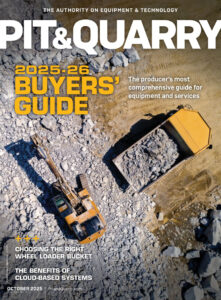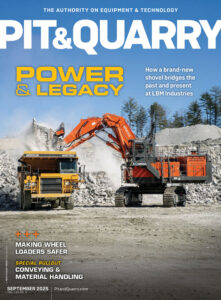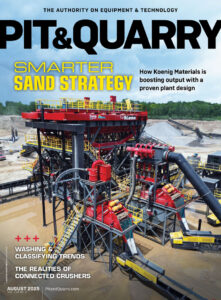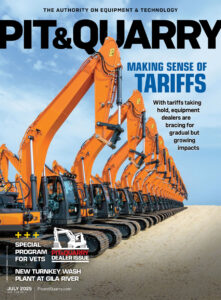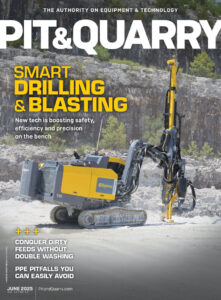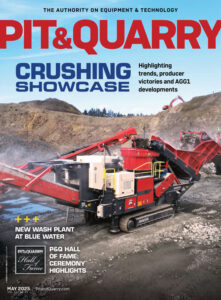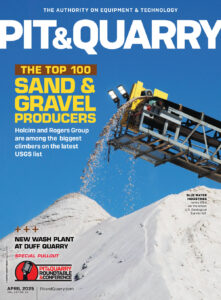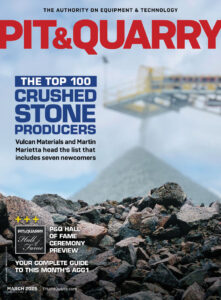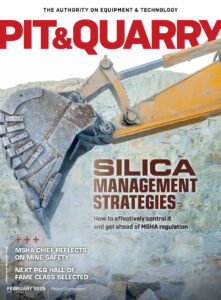Author
Webinar to outline transportation bill details rescheduled
Jack Schenendorf, an attorney with the law firm Covington & Burling LLP and a staff member of the House Transportation and Infrastructure Committee, will lead an NSSGA webinar Aug. 6 at 3 p.m. EDT that outlines what’s in the transportation bill for your business these next two years. The webinar was originally scheduled for July 30. Schenendorf, who has served on the Transportation and Infrastructure Committee for nearly 25 years, will focus on the bill’s funding, program reforms and streamlining provisions. Keep Reading
Main to meet with aggregates operators in Seattle
MSHA Assistant Secretary of Labor Joe Main will speak and take questions in Seattle next month as part of MSHA’s planned outreach to the aggregates sector this summer, NSSGA reports. Main will conduct the stakeholder meeting Sept. 10-12, and Bruce Chattin, the executive director of the Washington Aggregates and Concrete Association, will serve as host. Keep Reading
West Virginia senator introducing mine safety bill
NSSGA reports Sen. Jay Rockefeller (D-W.Va.) has introduced new mine safety legislation that includes a number of items seen in previous mine safety bills. Last week, NSSGA reported that Sen. Tom Harkin (D-Iowa) was developing new mine safety legislation, and he indeed is, but as a co-sponsor along with Sens. Patty Murray (D-Wash.) and Joe Manchin (D-W.Va.). According to NSSGA, the Rockefeller bill would increase civil and criminal penalties for operators, while subjecting officers, directors and agents to liability for knowing violations of the Mine Act or its regulations. The bill would also redefine a significant and substantial (S&S) violation to mean a violation that could "contribute to the cause and effect of a safety or health hazard if there is reasonable possibility that such violation could result in injury or death.” A new maximum penalty of $150,000 would also be imposed for an S&S violation. The new bill would also adopt a strong new pattern-of-violations system that codifies several aspects of the proposed rule put forward by MSHA last… Keep Reading
Construction spending at highest level in 36 months
Construction spending in June rose to a 2 ½-year high as double-digit percentage increases in private residential and nonresidential construction offset an ongoing downturn in public construction, according to an analysis of new federal data released by the Associated General Contractors of America. Association officials say the disparity between private and public construction is likely to persist, and they are urging policymakers to put more funding into infrastructure projects. “The June spending gains come on top of upward revisions to May and April totals, reinforcing the notion that private construction is now growing consistently,” says Ken Simonson, the association’s chief economist. “Even more encouraging, the improvement is showing up in a wide range of residential and nonresidential categories.” Simonson says total construction spending gained 0.4 percent for June and 7.0 percent year-over-year. Private nonresidential spending climbed for the fourth consecutive month and was 14 percent higher than in June 2011. Residential construction increased 1.3 percent for the month and 12 percent year-over-year, with new multifamily construction up 3.4 percent and… Keep Reading
GE Mining acquires underground mine vehicles manufacturer
GE Mining has acquired Fairchild International, an underground mine vehicles manufacturer based in Glen Lyn, Va. The new business name for the entity acquired is GE-Fairchild LLC. GE-Fairchild will employ about 140 people and manufacture equipment like diesel- and battery-powered scoops, continuous miners, haulage systems, shield haulers and maintenance vehicles. Keep Reading
Caterpillar selling part of Bucyrus distribution business
Caterpillar Global Mining LLC and Hewitt Equipment Ltd. have signed an agreement for Hewitt and its subsidiary, Atlantic Tractors & Equipment Ltd., to acquire Caterpillar’s Bucyrus equipment distribution and support business in Quebec, Western Labrador and the Maritimes. Hewitt Equipment is a Cat dealer. Caterpillar has announced similar transactions with other Cat dealers over the last few months. The company says it continues to hold discussions with other dealers who have mining activity in their territories, and that it will continue to operate the former Bucyrus distribution business until transitions have been made. Keep Reading
Vulcan Materials releases second-quarter earnings summary
Vulcan Materials Co. shared its second-quarter earnings summary last week, announcing that its aggregates segment gross profit improved 9 percent due to increased productivity and cost-reduction initiatives. Vulcan’s aggregates shipments increased slightly on a same-store basis from the prior year period, notwithstanding the pull-forward effect of seasonally favorable weather conditions during the first quarter and the effects of Tropical Storm Debby in Florida in June. Overall, Vulcan shipments decreased 1 percent due to the sale of operations in Indiana last year. Also, aggregates pricing increased slightly, offsetting some of the earnings effect of a less favorable geographic mix. “Despite weaker volumes in several of our most profitable markets, aggregates segment gross profit margin improved by 220 basis points,” says Don James, Vulcan’s chairman and CEO. “Cash earnings per ton of aggregates increased to $4.57 per ton." James adds that trends in both private- and public-sector construction markets are positive. “In particular, we are encouraged by the passage of the new multi-year highway bill by Congress in late June, which should provide state… Keep Reading
Martin Marietta shares second-quarter results
Martin Marietta Materials Inc. released its second-quarter results today, noting that its heritage aggregates business-operating margin expanded 150 basis points and that the company’s specialty products group posted record second-quarter net sales. “Our second-quarter results once again reflect the powerful combination of increases in shipment volume and average selling prices in our heritage aggregates product line,” says Ward Nye, Martin Marietta’s president and CEO. Underlying the increases are continuing indications of recovery in certain areas of Martin Marietta’s markets, Nye adds, predominantly in the western United States. In particular, heritage volume growth in Texas was driven by increased shipments to both the energy sector and the residential end-use markets. “Looking ahead, the positive momentum generated in the first half of the year, together with the recent passage of a new federal highway bill and regionalized improvement in home building, have bolstered our optimism for construction activity,” Nye says. Keep Reading
McLanahan introduces filter press line
McLanahan Corp. has launched its first line of filter presses, eliminating the need for slurry ponds and a full-time operator. McLanahan says the presses produce dry cakes and use fewer chemicals. The filter press technology treats the underflow of a thickener, clarifier or other waste and dewatering processes. Both overhead-beam and side-beam designs are options, and both designs can feature either recessed chamber filter plates or membrane filter plates, with a wide range of available pressures ranging from 225 to 725 psi. Other options are core blow systems and automatic wash systems. Keep Reading


